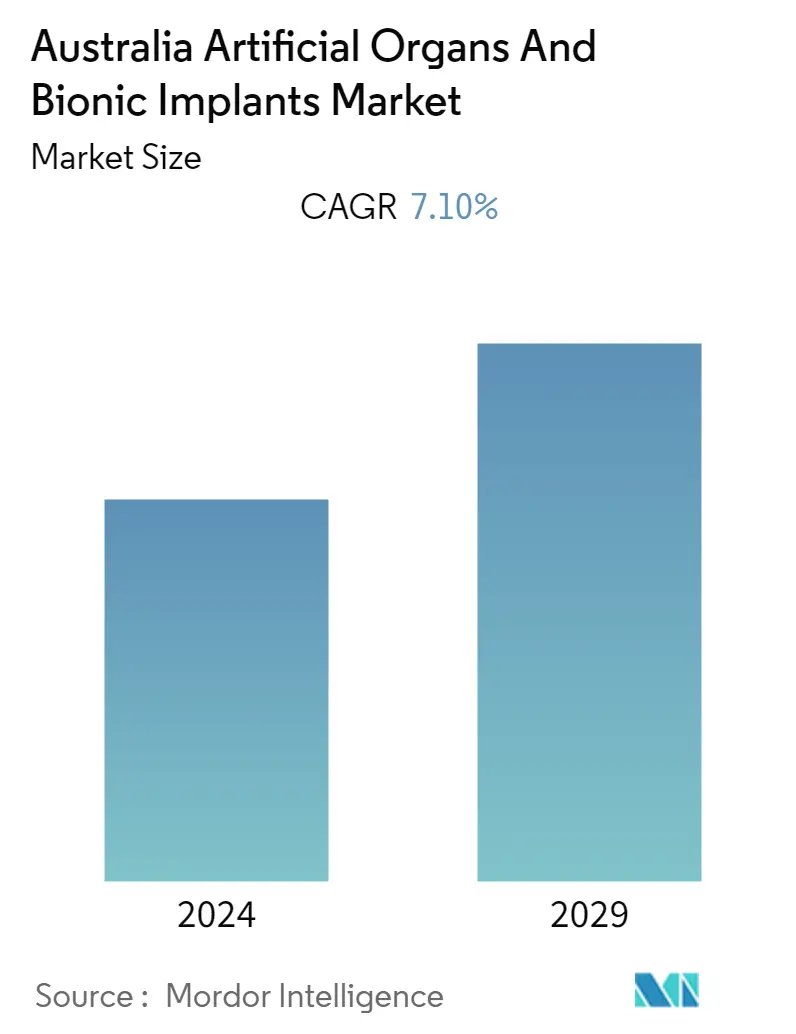Market Size of Australia Artificial Organs And Bionic Implants Industry

| Study Period | 2019 - 2029 |
| Base Year For Estimation | 2023 |
| Forecast Data Period | 2024 - 2029 |
| Historical Data Period | 2019 - 2022 |
| CAGR | 7.10 % |
Major Players
*Disclaimer: Major Players sorted in no particular order |
Australia Artificial Organs And Bionic Implants Market Analysis
Australia artificial organs and bionics market is expected to register a CAGR of 7.1% over the forecast period.
- The COVID-19 pandemic impacted the studied market significantly. During the initial phase of the pandemic, the number of organ transplants and surgeries decreased to avoid the contamination and spread of coronavirus. According to the study published in Kidney International in October 2020, the Australian National Transplantation and Donation Rapid Response Taskforce recommended the suspension of all adult kidney transplantation as early post-transplant COVID-19 could result in severe illness and mortality. Only urgent heart, lung, liver, and pediatric transplantation continued, following a case-by-case assessment of risks and benefits. Such instances led to a negative impact on market growth during the pandemic. However, with resumed services and transplantation procedures, the studied market is expected to witness significant growth over the forecast period. Furthermore, post-pandemic, the market is expected to drive significantly to transplant organs in patients who lagged during the pandemic.
- Certain factors that are propelling the market growth are the rising number of chronic diseases and technological advancements in artificial organs and bionics. The increasing prevalence of chronic diseases such as cardiovascular disease, diabetes, kidney diseases, and others is the key factor driving the market growth due to the rise in demand for artificial organs. For instance, according to the Australian Institute of Health and Welfare, in 2022, almost half (47%, or 11.6 million) of Australians were estimated to have one or more common chronic health conditions, including diabetes, cancer, and chronic kidney disease in the year 2021. Such a huge number of chronic diseases in the Australian population is anticipated to drive market growth due to the increased adoption of artificial organs in organ failure patients.
- Additionally, as per the data published by the Australian Institute of Health and Welfare in August 2022, it has been observed that in Aboriginal and Torres Strait Islanders, 292 males and 677 females per 100,000 population have chronic kidney diseases, respectively, in 2021. As per the same source, Indigenous Australians were 4.6 times more likely to be diagnosed with chronic kidney disease than their non-Indigenous counterparts. Thus, the rising burden of kidney disease among the population can lead to kidney failure, which is expected to increase the demand for medical bionics and artificial kidney transplants, thereby propelling market growth.
- Furthermore, the rising initiatives from researchers in Australia are expected to drive market growth over the forecast period. For instance, in December 2021, biomedical researchers at the University of Sydney and UNSW developed a bionic eye that has shown to be safe and stable for long-term implantation in a three-month study, paving the way for human trials. Such innovations by the researchers will lead to rising approvals in Australia, leading to increased adoption and market growth.
- Therefore, factors such as the rising prevalence of chronic diseases such as cardiovascular disease, diabetes, kidney diseases, and others is the key factor driving the market growth. Furthermore, technological advancements in artificial organs and bionics are expected to drive market growth. However, the high cost of the procedure is likely to impede market growth over the forecast period.
Australia Artificial Organs And Bionic Implants Industry Segmentation
Artificial organs are human-made mechanical devices that can be implemented temporarily or permanently in human bodies as a substitute for a body organ. Bionics refers to the replacement or improvement of body parts by mechanical kinds.
The Australia artificial organs and bionics market is segmented by type (artificial organ (artificial heart, artificial kidney, cochlear implants, and other organ types) and bionics (ear bionics. orthopedic bionics, cardiac bionics, and other bionics)).
The report offers the value (in USD) for the above segments.
| By Type | ||||||
| ||||||
|
Australia Artificial Organs And Bionic Implants Market Size Summary
The Australia artificial organs and bionics market is poised for substantial growth, driven by the increasing prevalence of chronic diseases and advancements in technology. The market experienced a temporary setback during the COVID-19 pandemic due to a reduction in organ transplants and surgeries, but has since rebounded as services resumed. The rising incidence of conditions such as cardiovascular disease, diabetes, and kidney diseases has heightened the demand for artificial organs, particularly in organ failure patients. Technological innovations, such as the development of a bionic eye by researchers at the University of Sydney and UNSW, are expected to further propel market expansion. Despite the high costs associated with these procedures, the market is anticipated to grow steadily over the forecast period.
The artificial kidney segment is expected to see significant growth due to the increasing number of kidney transplantations and the high prevalence of renal failures. The demand for artificial kidneys is driven by the rising cases of chronic kidney disease, particularly among Indigenous Australians, who are disproportionately affected. Additionally, the cochlear implants and ear bionics segment is anticipated to grow, fueled by the rising prevalence of hearing loss in Australia and the introduction of innovative products by key market players. Companies like Cochlear Ltd and Control Bionics, Inc. are actively expanding their offerings, contributing to the competitive landscape of the market. Overall, the market is characterized by moderate competition, with global players leading in manufacturing and innovation.
Australia Artificial Organs And Bionic Implants Market Size - Table of Contents
-
1. MARKET DYNAMICS
-
1.1 Market Overview
-
1.2 Market Drivers
-
1.2.1 Rising Number of Chronic Diseases
-
1.2.2 Technological Advancements in the Artificial Organ and Bionics
-
-
1.3 Market Restraints
-
1.3.1 High Cost of Procedure
-
-
1.4 Porter's Five Forces Analysis
-
1.4.1 Threat of New Entrants
-
1.4.2 Bargaining Power of Buyers/Consumers
-
1.4.3 Bargaining Power of Suppliers
-
1.4.4 Threat of Substitute Products
-
1.4.5 Intensity of Competitive Rivalry
-
-
-
2. MARKET SEGMENTATION (Market Size by Value - USD)
-
2.1 By Type
-
2.1.1 Artificial Organ
-
2.1.1.1 Artificial Heart
-
2.1.1.2 Artificial Kidney
-
2.1.1.3 Cochlear Implants
-
2.1.1.4 Other Organ Types
-
-
2.1.2 Bionics
-
2.1.2.1 Ear Bionics
-
2.1.2.2 Orthopedic Bionic
-
2.1.2.3 Cardiac Bionics
-
2.1.2.4 Other Bionics
-
-
-
Australia Artificial Organs And Bionic Implants Market Size FAQs
What is the current Australia Artificial Organs & Bionic Implants Market size?
The Australia Artificial Organs & Bionic Implants Market is projected to register a CAGR of 7.10% during the forecast period (2024-2029)
Who are the key players in Australia Artificial Organs & Bionic Implants Market?
Abiomed Inc, LivaNova PLC, Bionic Vision Technologies, Ossur and Cochlear Ltd are the major companies operating in the Australia Artificial Organs & Bionic Implants Market.

